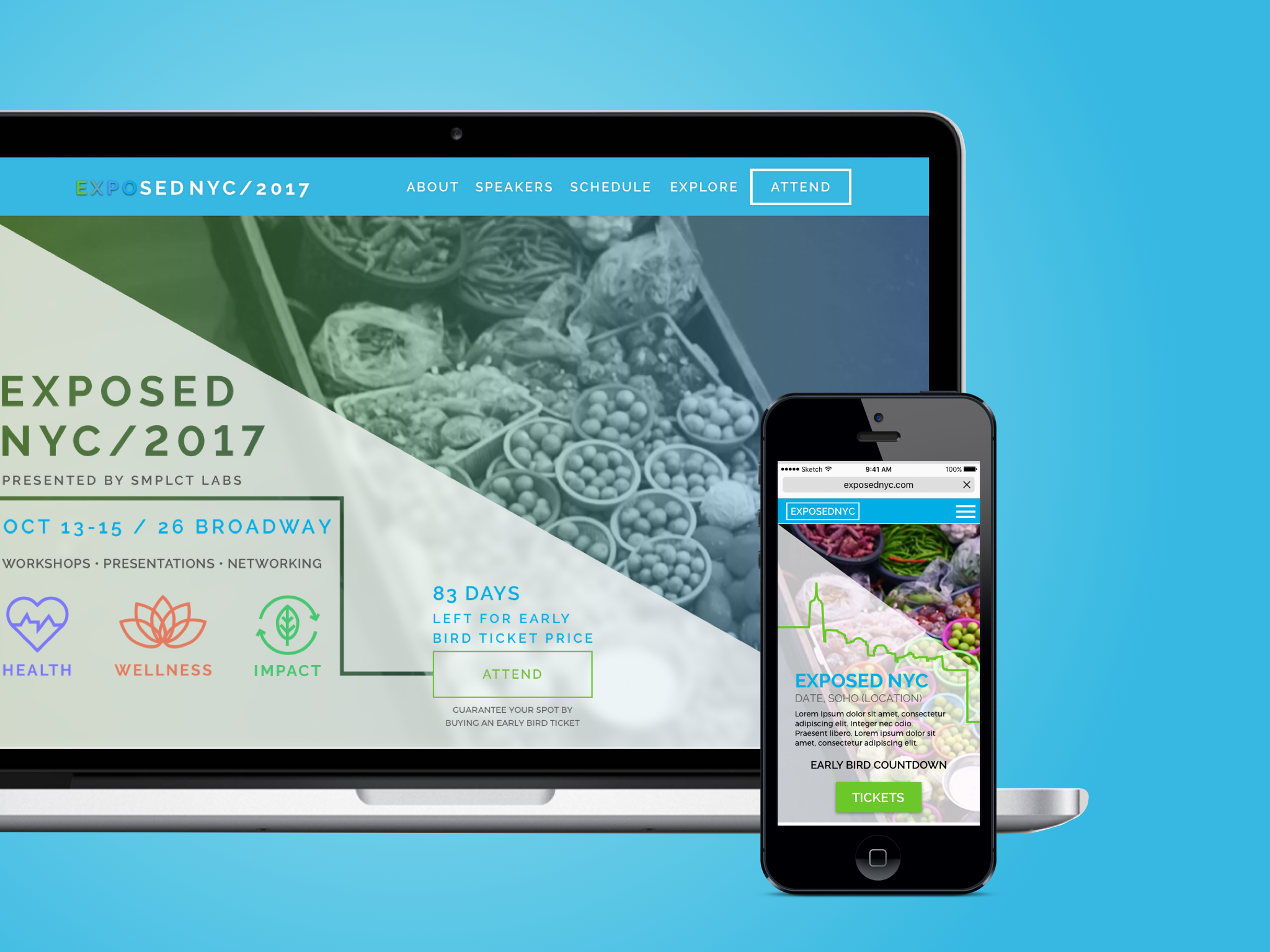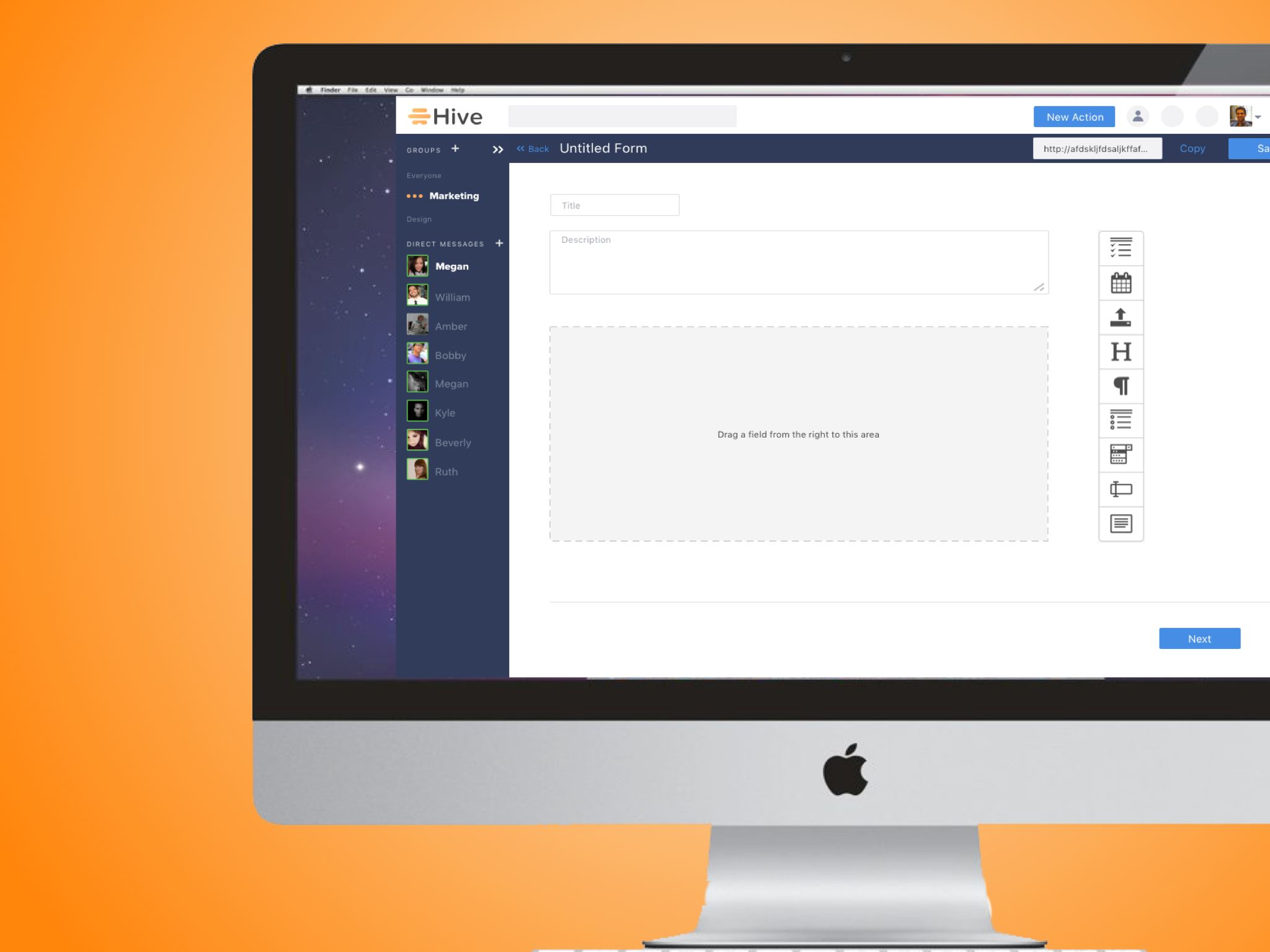
In spring of 2017, I had the opportunity to work with the NYC Department of Education Department of Student Enrollment. I led the research efforts for design recommendations for NYC School Finder 2.0. We presented our designs to senior policymakers at the DOE headquarters in May 2017.
In New York City, students are given the rare opportunity to apply to up to twelve programs in any of the 5 boroughs. Though students can list up to a dozen programs on their application, research shows that in 2016, they listed on average 6 or 7 – making it less likely that they would receive a Round 1 offer.
We had the opportunity to take SchoolFinder to the next level, making it not only an online, interactive directory– but also a guide.
How might we increase the number of programs families list, increasing their chances of getting a round 1 offer?
The New York City Department of Education is the largest school district in the U.S. serving over 1.1 million students in nearly 2,000 schools. New York City has more than 400 high schools and over 700 programs. And students apply directly to programs, not schools. Using books, articles, and previous research from the DOE, we discovered the complexity of the debate about the city and country’s education system.
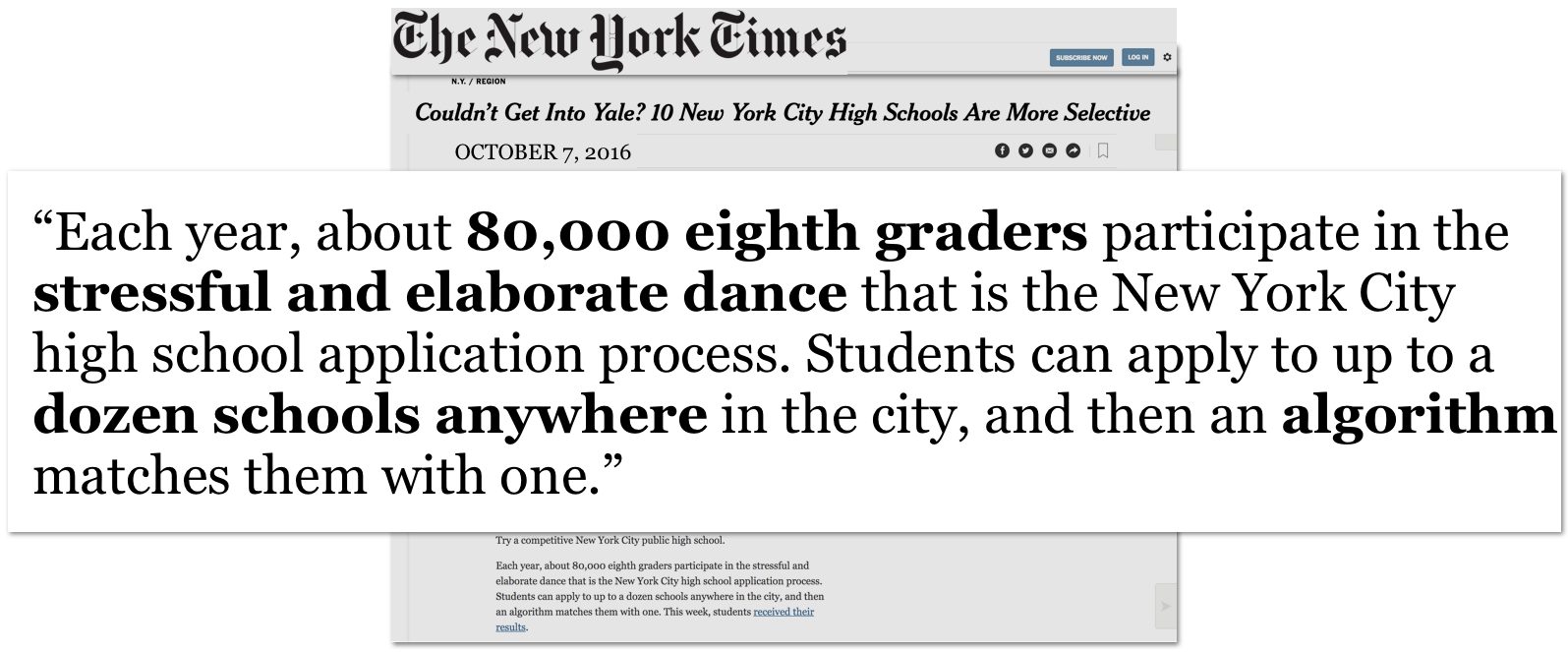
In 2004 under Mayor Michael Bloomberg, a universal high school choice process was implemented. Under this system, all incoming high school freshmen are required to rank up to 12 programs they would like to attend. There is no default school assignment, meaning everyone has to choose.
Mayor De Blasio’s Equity and Excellence initiative meant that our designs must give everyone what they need to be successful. We worked within the perameters of limited accessibility and data usage for low-income families. New York City is socio-economically diverse, with 76.5% of students qualifying in poverty.
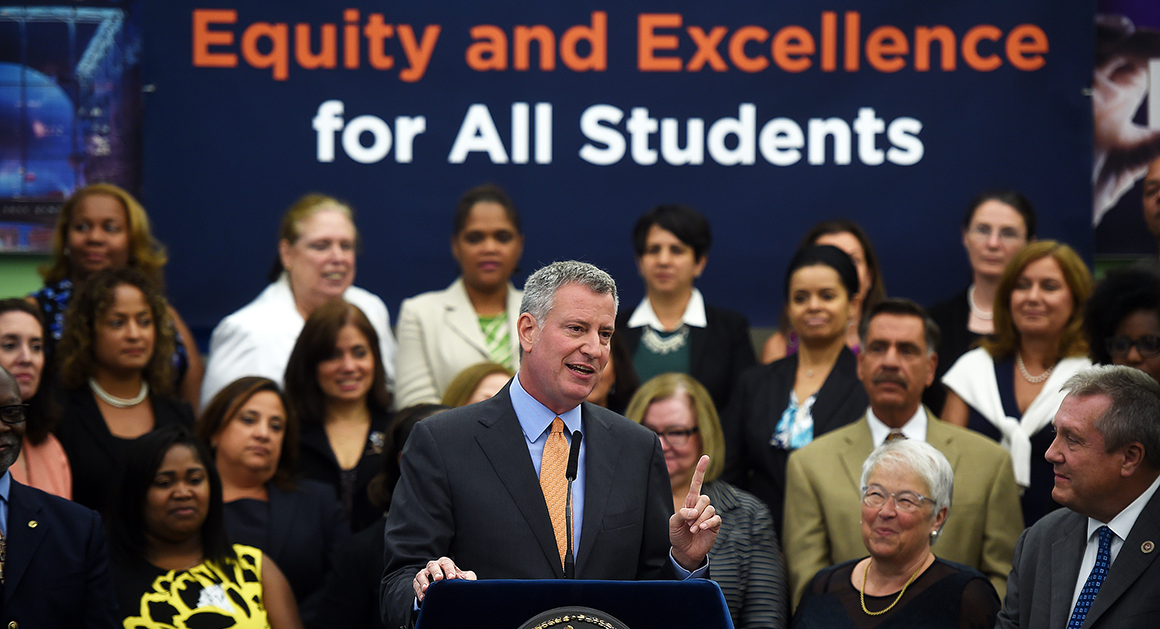
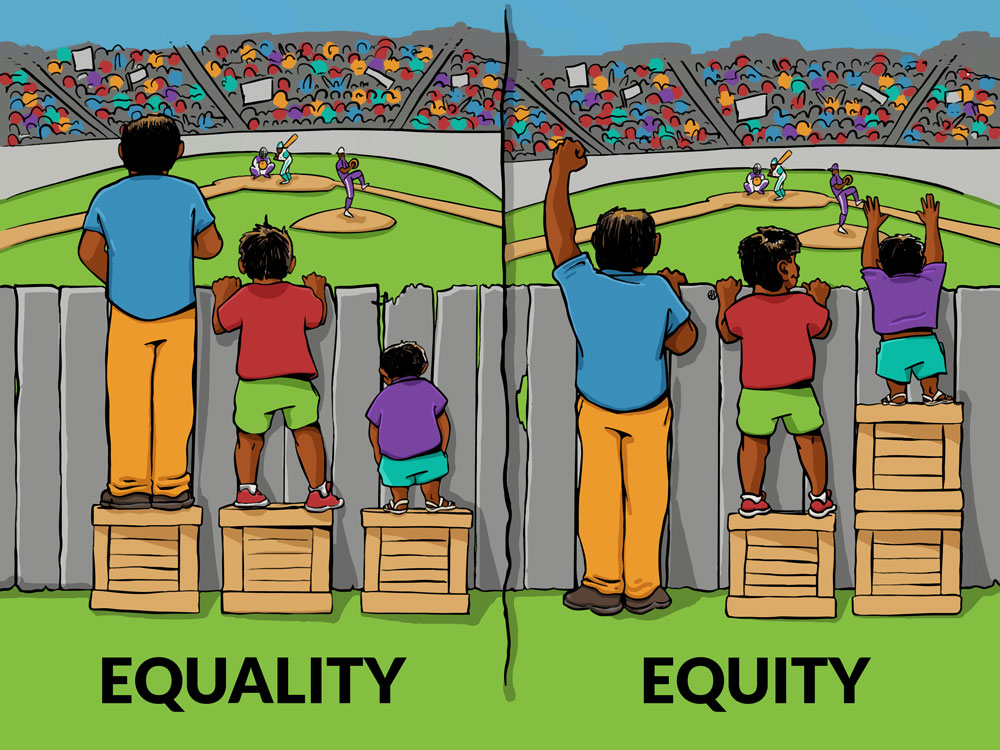
We clearly defined the difference between equity and equality. Equality meant giving each student equal opportunity, while equity means factoring in the positioning and resources of a student, lifting up the student who needs it most. We measured each design choice to align with the mayoral equity policy.
“It’s a priority for us at the Department of Education to make the enrollment process easier for families”…“That’s really a part of Equity and Excellence [the mayor’s education agenda], ensuring that families have access to quality information in as easy a way as possible so they can make the best choices for their kids.”– Josh Wallack, Deputy Chancellor, NYC Department of Education
Smartphone ownership is often most financially tenuous for the subset of users who depend on their mobile devices most heavily.
Smartphone owners with income of less than 30,000:
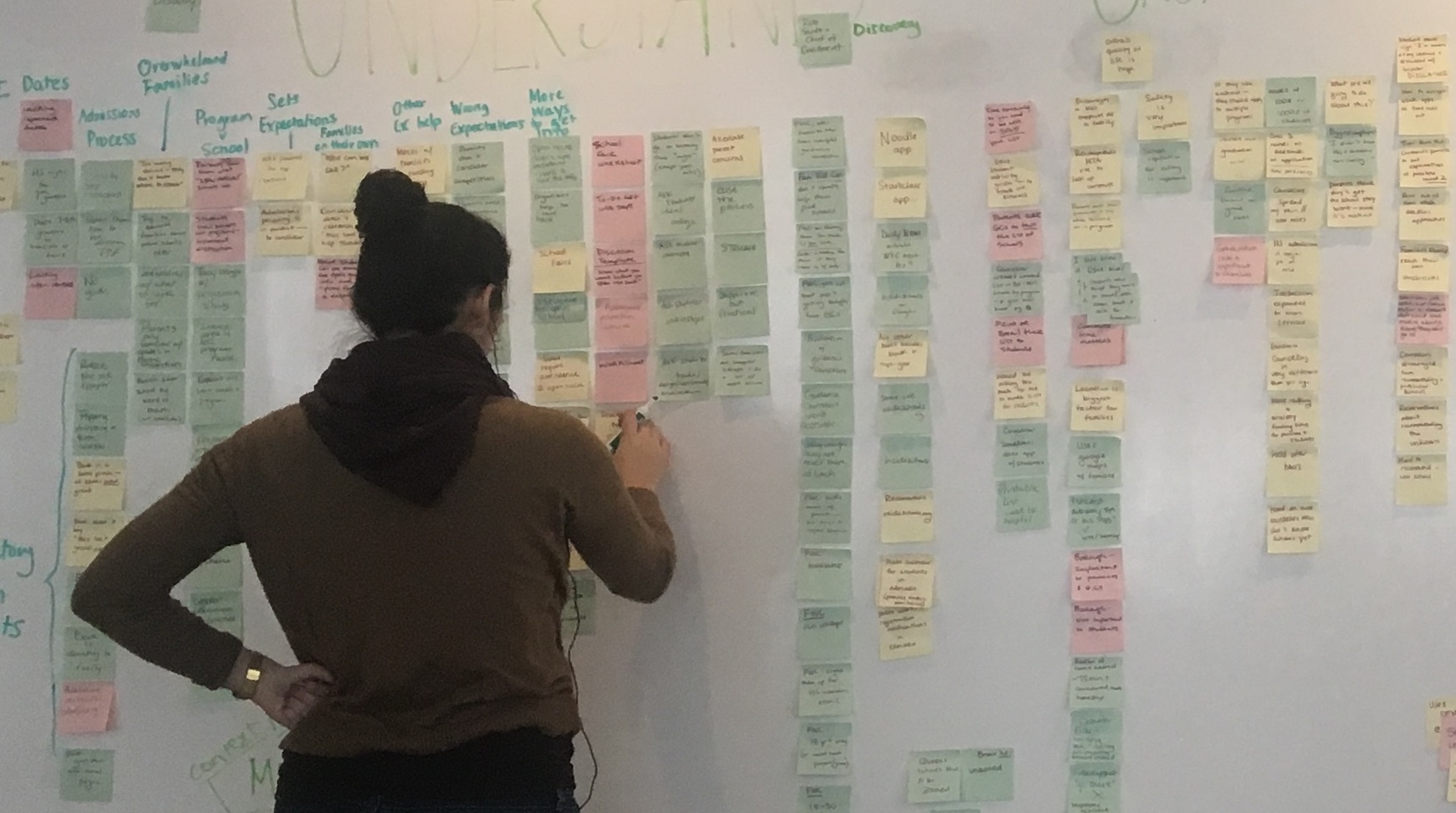
The DOE provided audio and transcripts of 24 past interviews and usability tests which led to the current MVP. We learned about the frustrations understanding the admissions and selection process. And that this was a pain point for educators, students and their families.
What: Round 2 high school admissions fair
Where: Martin Luther King campus on Upper West City of Manhattan
Observed firsthand how difficult it is to navigate and track programs of interest
Learned nothing can replace seeing a school in person or speaking directly with programs representatives
3 DOE staff members | 4 Guidance Counselors | 3 Parents

From our findings, we created a simplified user map and found students and families have questions throughout the entire yearlong admissions process.
Want families to understand the process and list more programs on the application
Want their questions answered throughout the process and easily track programs of interest
Want to educate students and families about the process and promote application diversity
We ideated on a large number of possible features, using the Moscow method below to identify an MVP.

My team ran a design studio, where we rapidly hand sketched our initial design ideas in a collaborative fashion, deciding on a final first iteration together.
We followed the golden rule– test early and test often.
Using a survey and our networks, we identified 9 target users who have or will go through the NYC high school admissions process.
We did 4 iterations and 4 rounds of testing.
DOE Provided Research: Families relied heavily on word-of-mouth
Expert Interviews: Guidance Counselors meet with students and families to explain the process even holding after hours workshops. Variety of factors affect why families choose programs; each carrying equal weight and importance
Contextual Inquiry: Tons of DOE staff, principals, GCs, and current students accessible to speak with
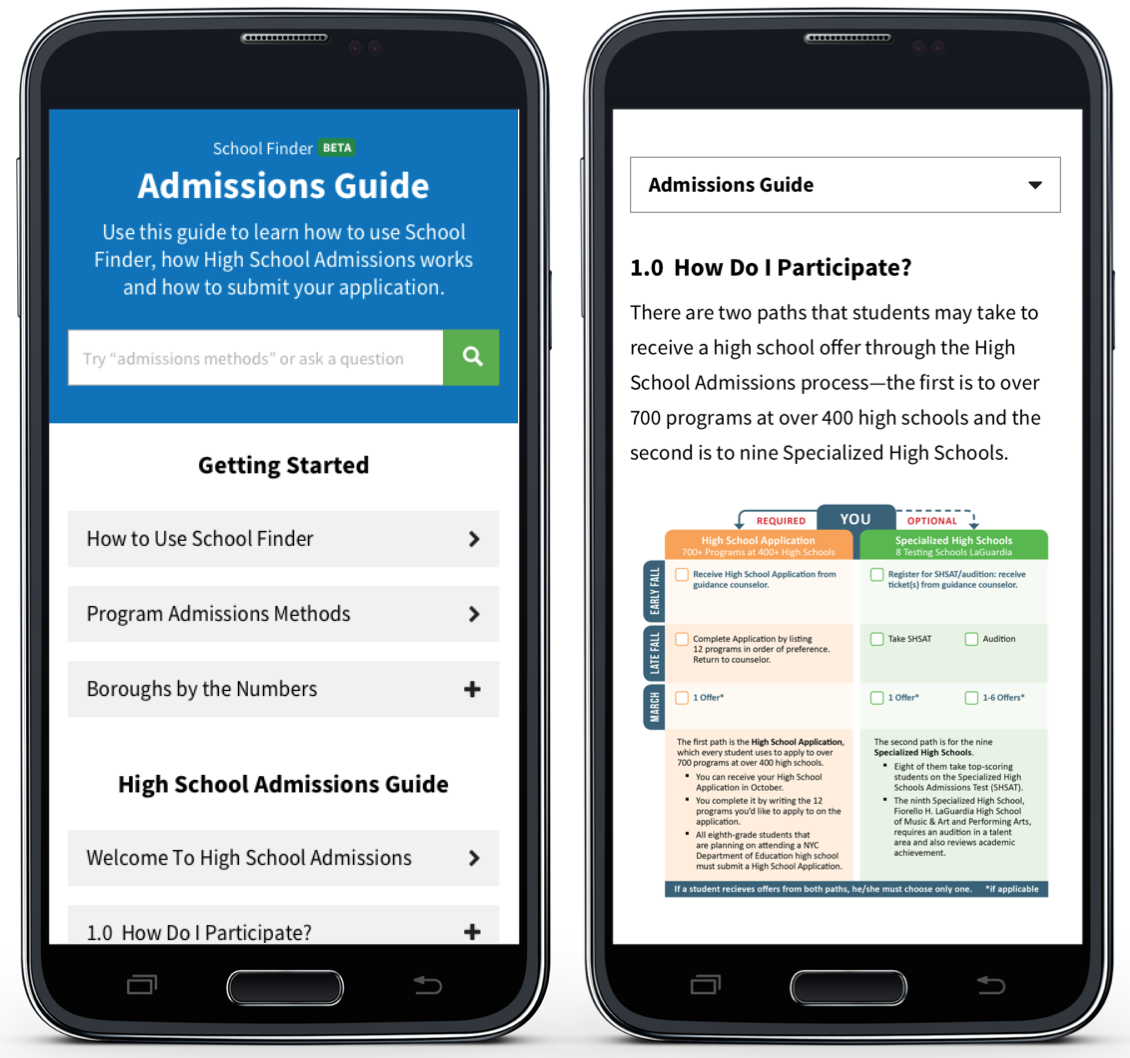
Change: Creating pages from current static Front of Book
Benefits: Access to key info/questions about process
Technical Requirements: Search function tagging
Accordion function: Expand/contract
DOE Provided Research & Expert Interviews: Families need guidance and have a range of tech familiarity
Expert Interviews & User Map: Students and families have questions during various steps of the process, each step is of equal importance
Expert Interviews & Usability Testing: Increase findability of different pages; Favorites not accessible from main page
Contextual Inquiry: 100% of users did not use NYC DOE logo to go back to main page

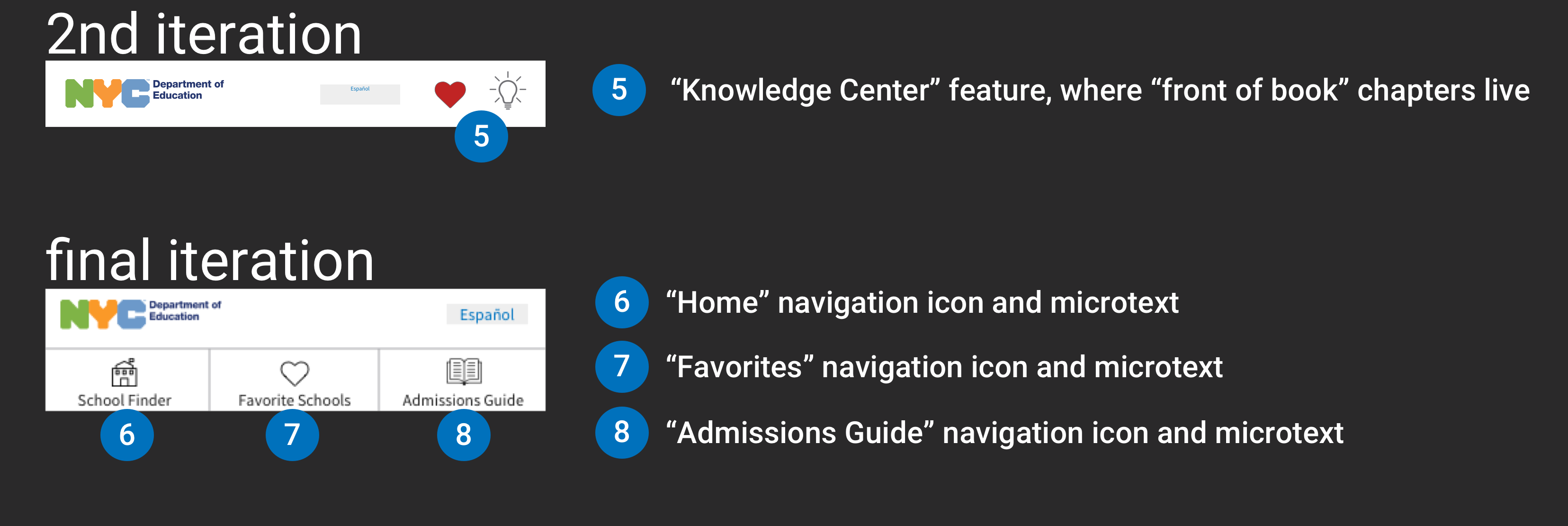
Change: Fully new feature
Benefits: Accessibility and findability of all pages
Technical Requirements: Add text and icons Front-end code to link pages Minimize navigation on scroll (Javascript)
DOE Provided Research: “I didn’t know this deadline was coming” is common complaint
DOE Provided Research & Expert Interviews: Dates on physical HS application and GCs have to constantly remind students of key dates and deadlines
User Map: Students and families need to know key dates and deadlines throughout the entire process
Contextual Inquiry: Signing in at a school fair/open house might affect chances of getting an offer. Ended the fair with a handful of flyers with dates on them.
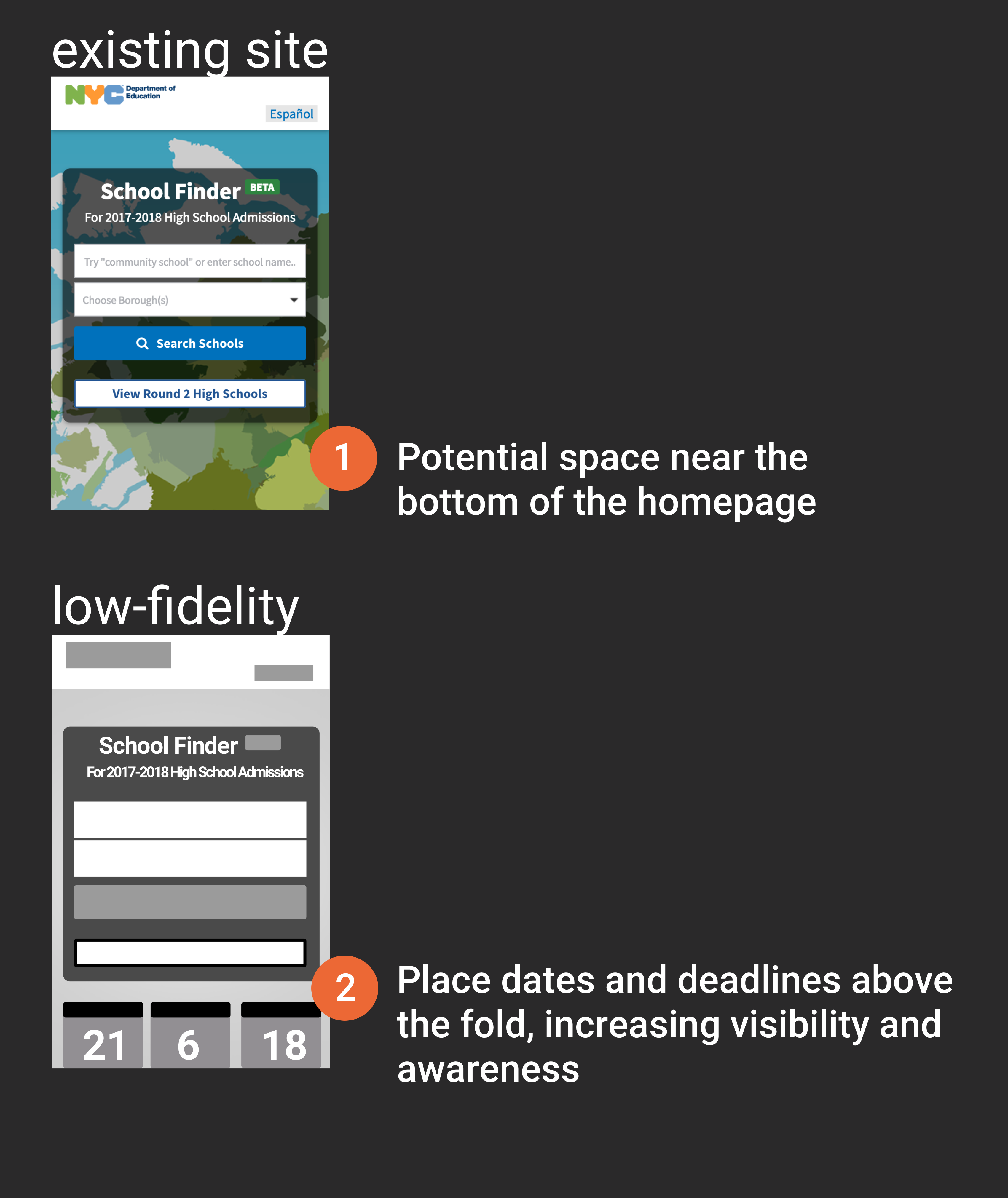
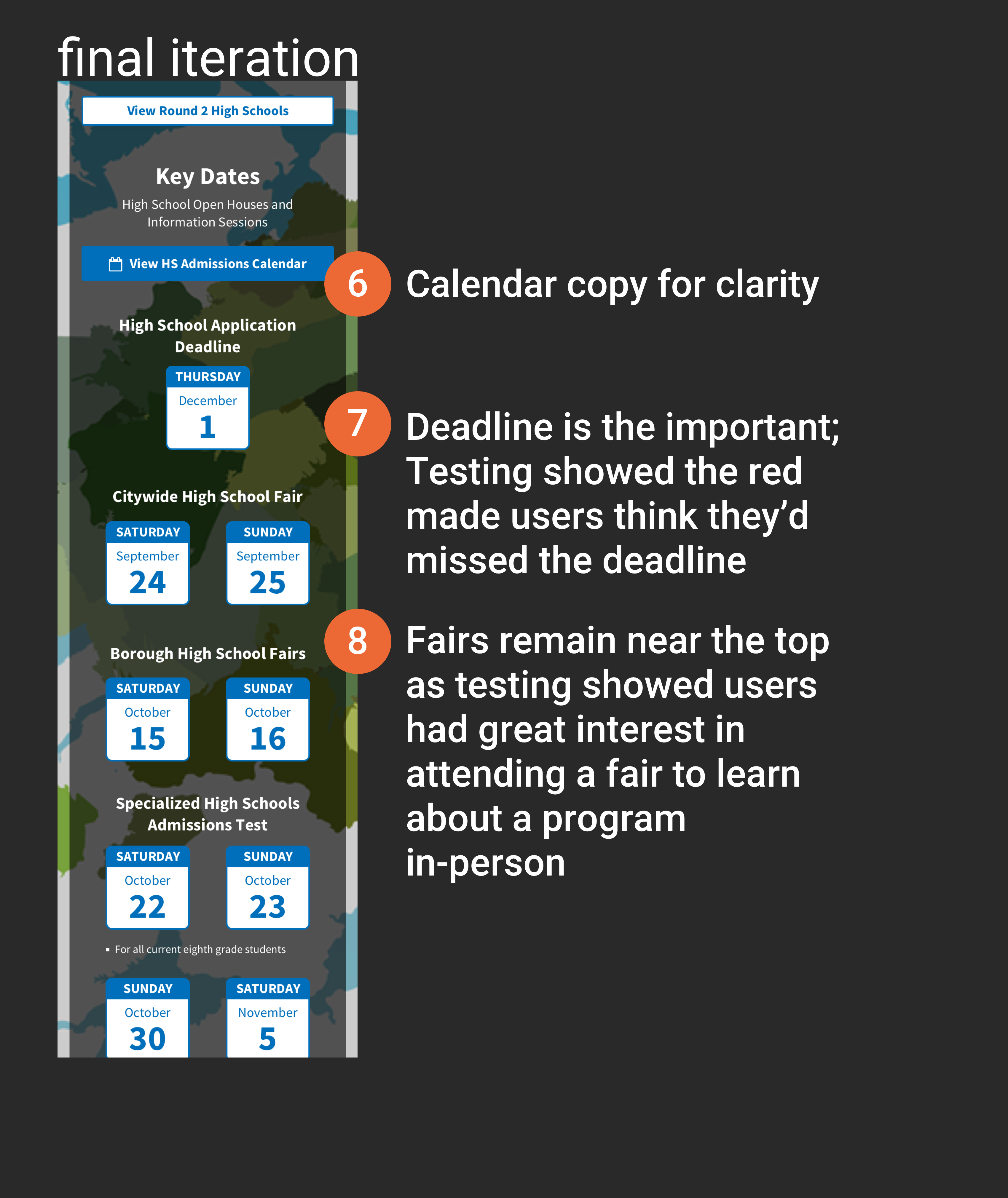
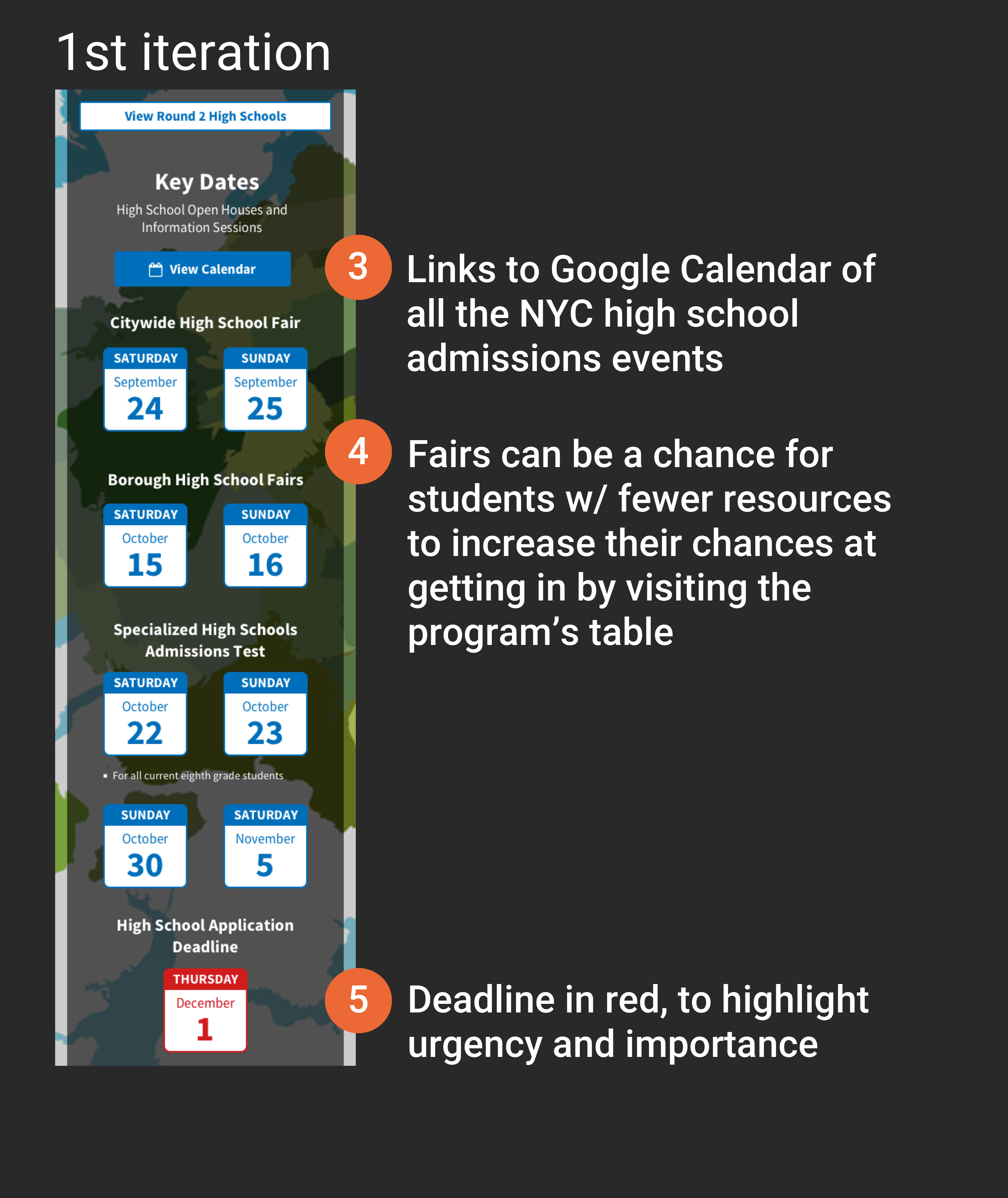
Change: Adding dates from directory and application to the homepage
Benefits: Visibility of reminders for key dates and deadlines
Technical Requirements: Add prominent images of key dates to homepage Move Google calendar link from the footer; make button for increased clickability
DOE Provided Research & Expert Interviews: Importance of promoting application diversity; both realistic and supportive with students and families.
Expert Interviews: Wanted the ability to save and share program lists with students and families more easily.
User Map: Program discovery lasted for several months. Contextual Inquiry: Flyers and email signs-up from fair were hard to track.
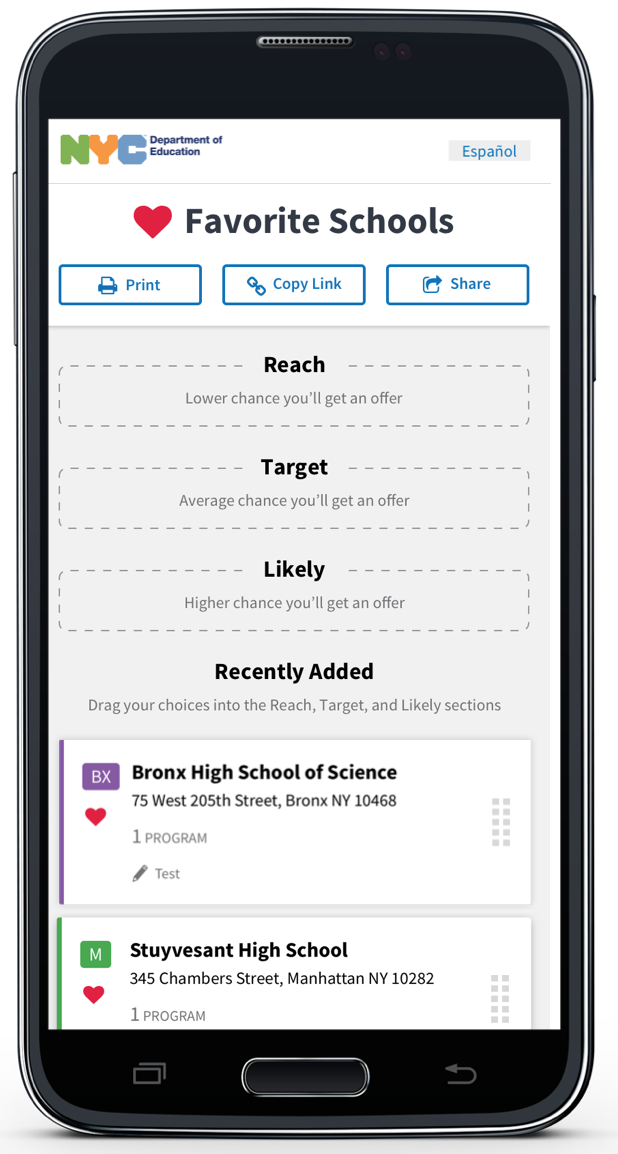
Change: Add Reach/Target/Likely sections
Ability to reorder favorites
Add copy link and share buttons
Benefits: Improve diversity of programs on application
Reinforces the R/T/L idea (and defines the terms) that you SHOULD apply to a range of programs.
Technical Requirements: Javascript for drag and drop function; front-end code to add buttons
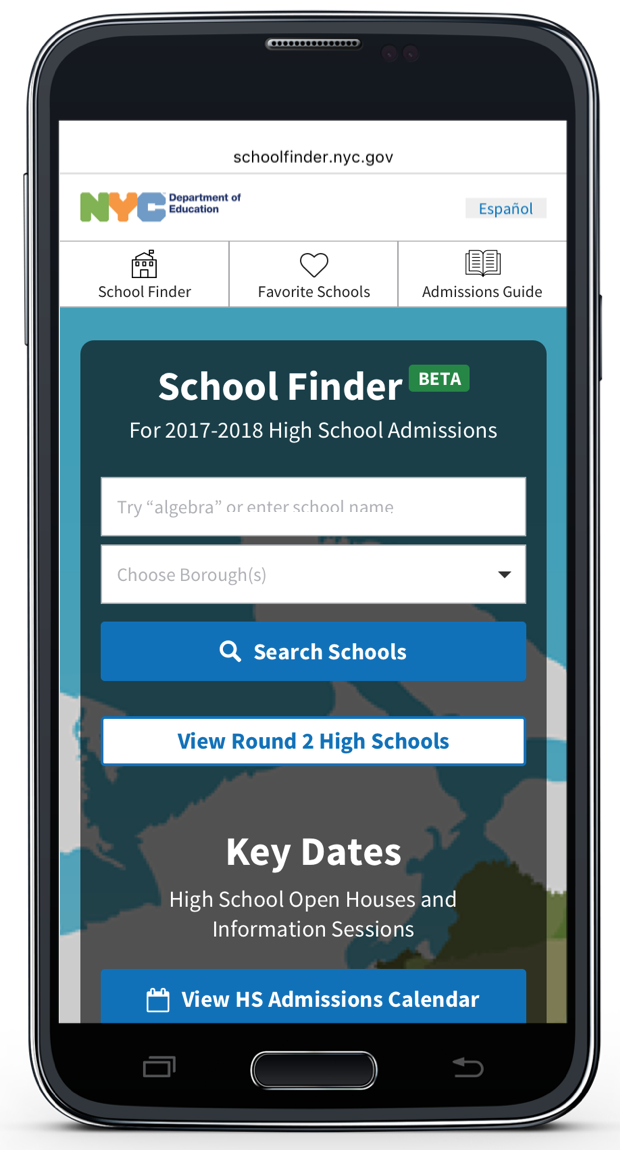
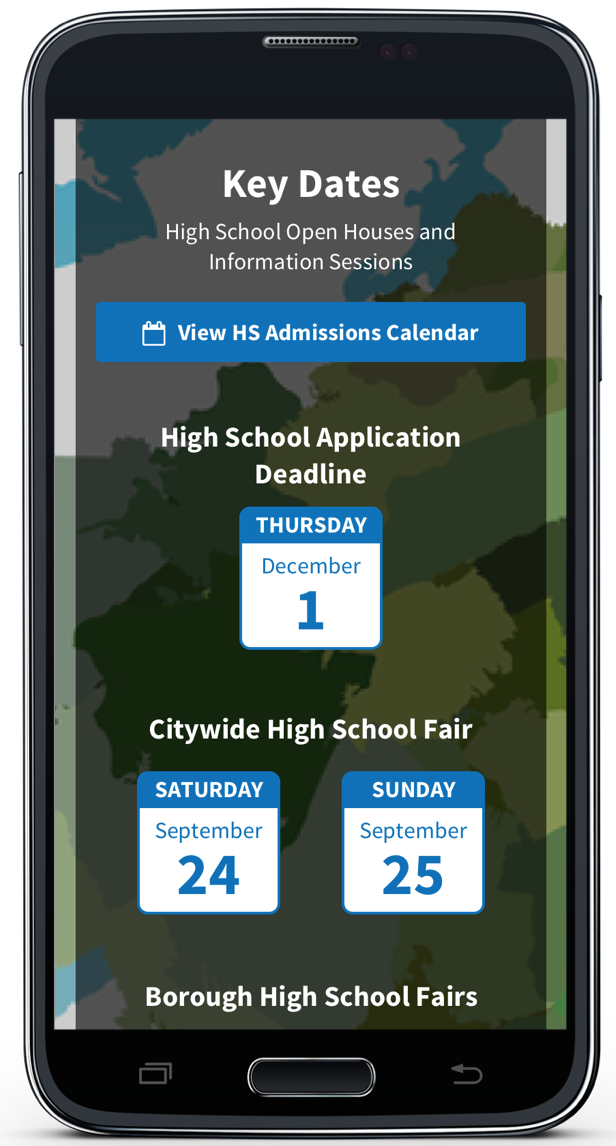

Recommendations for existing information architecture and user flow
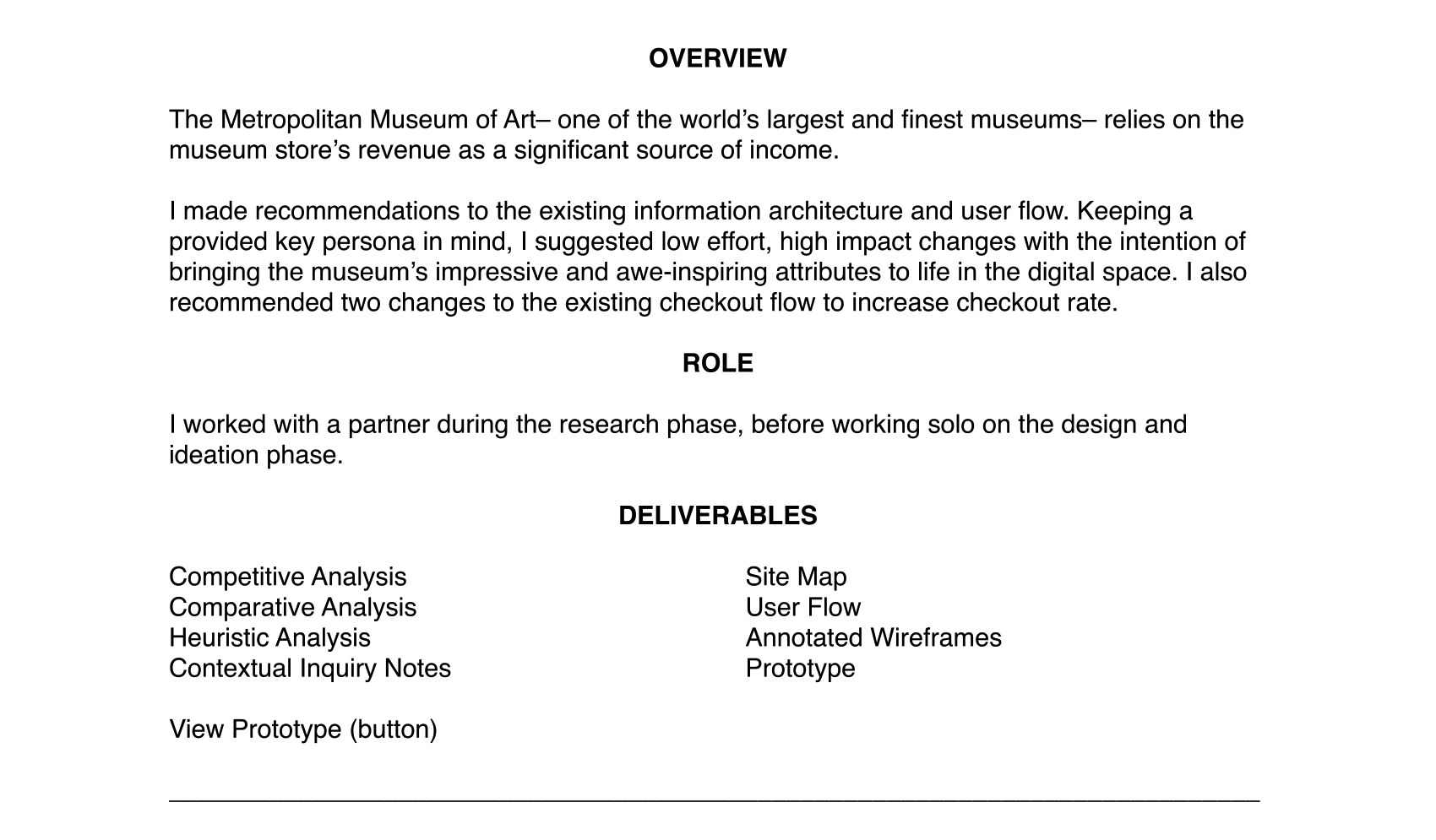
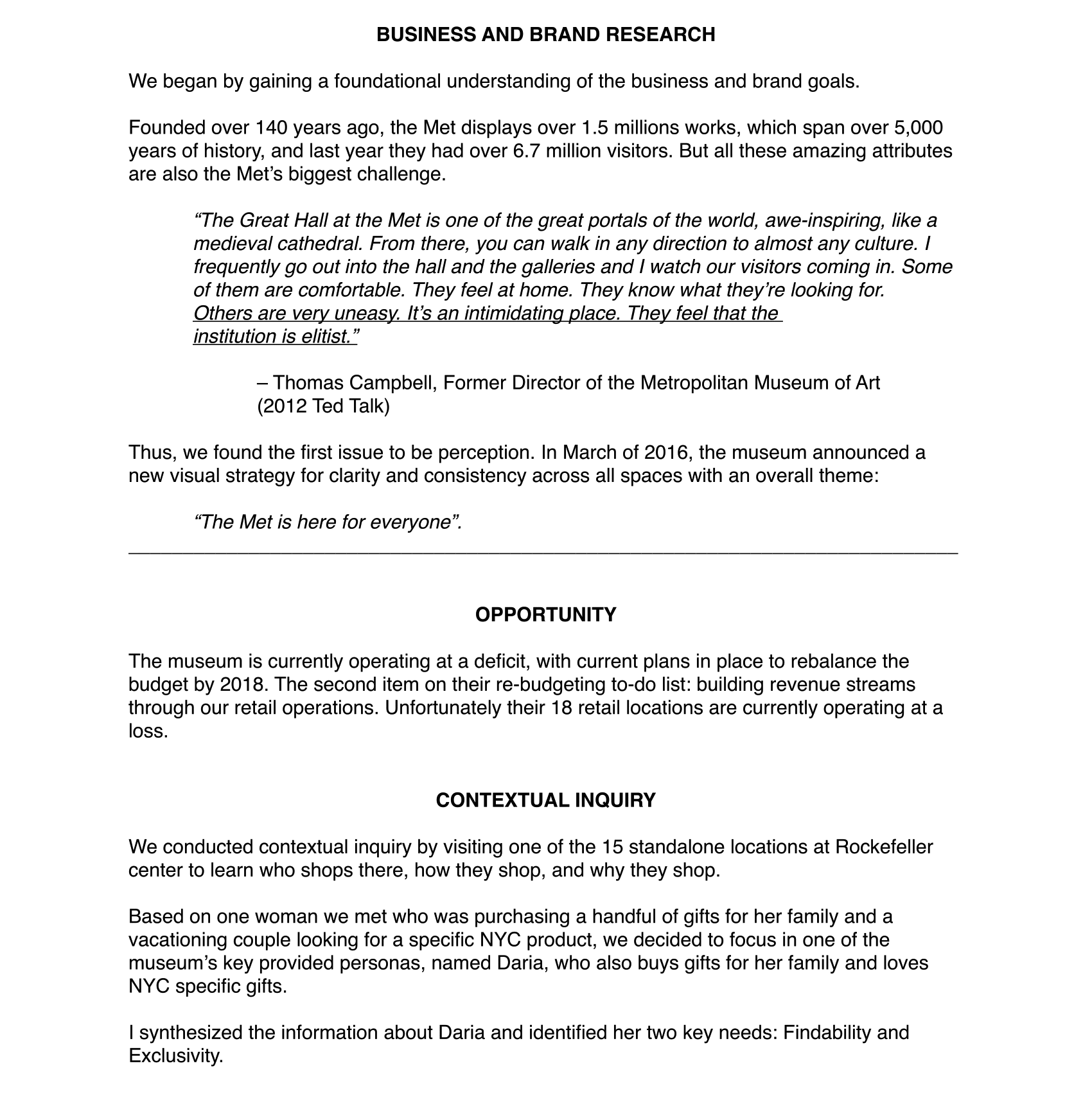
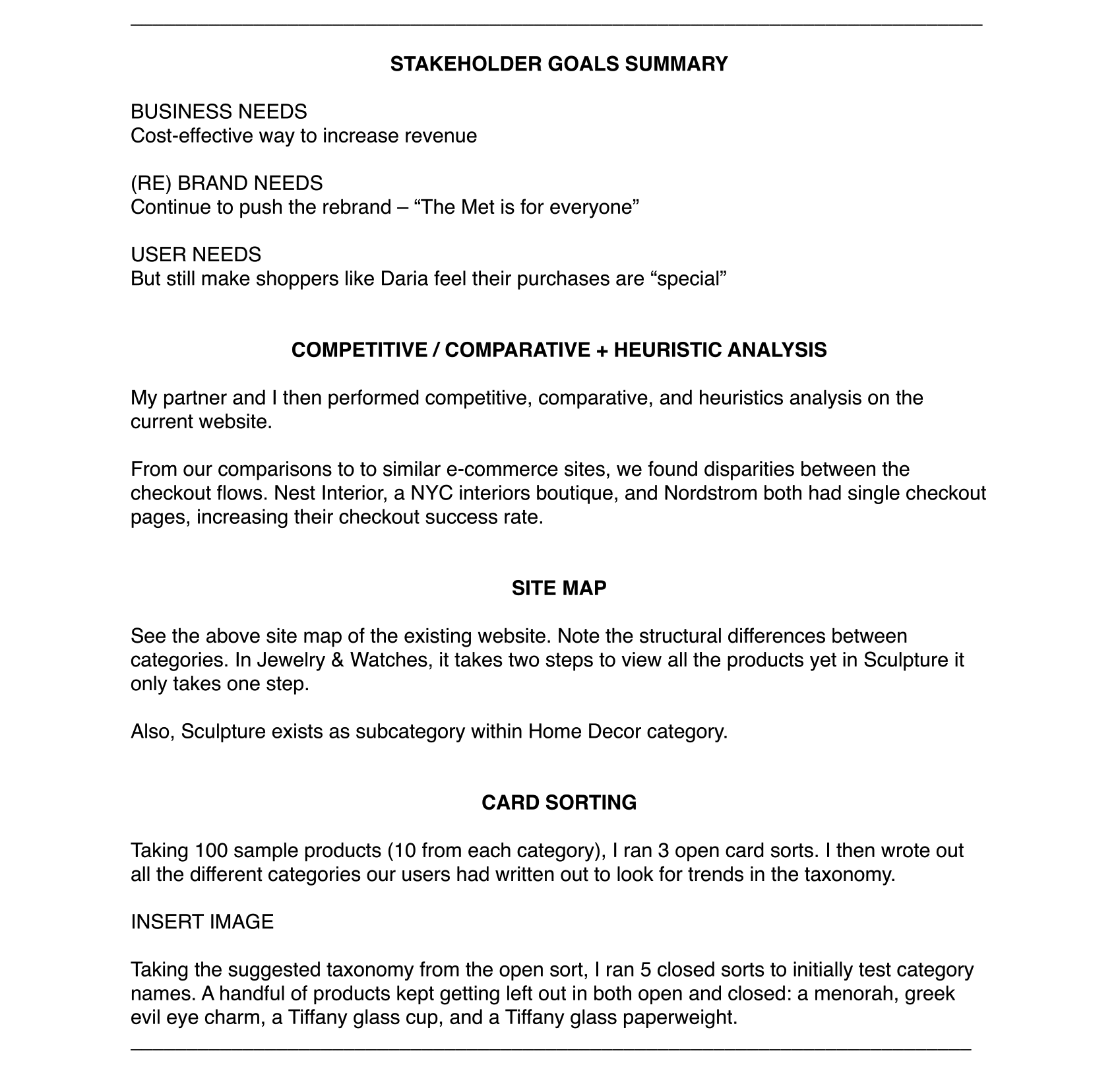
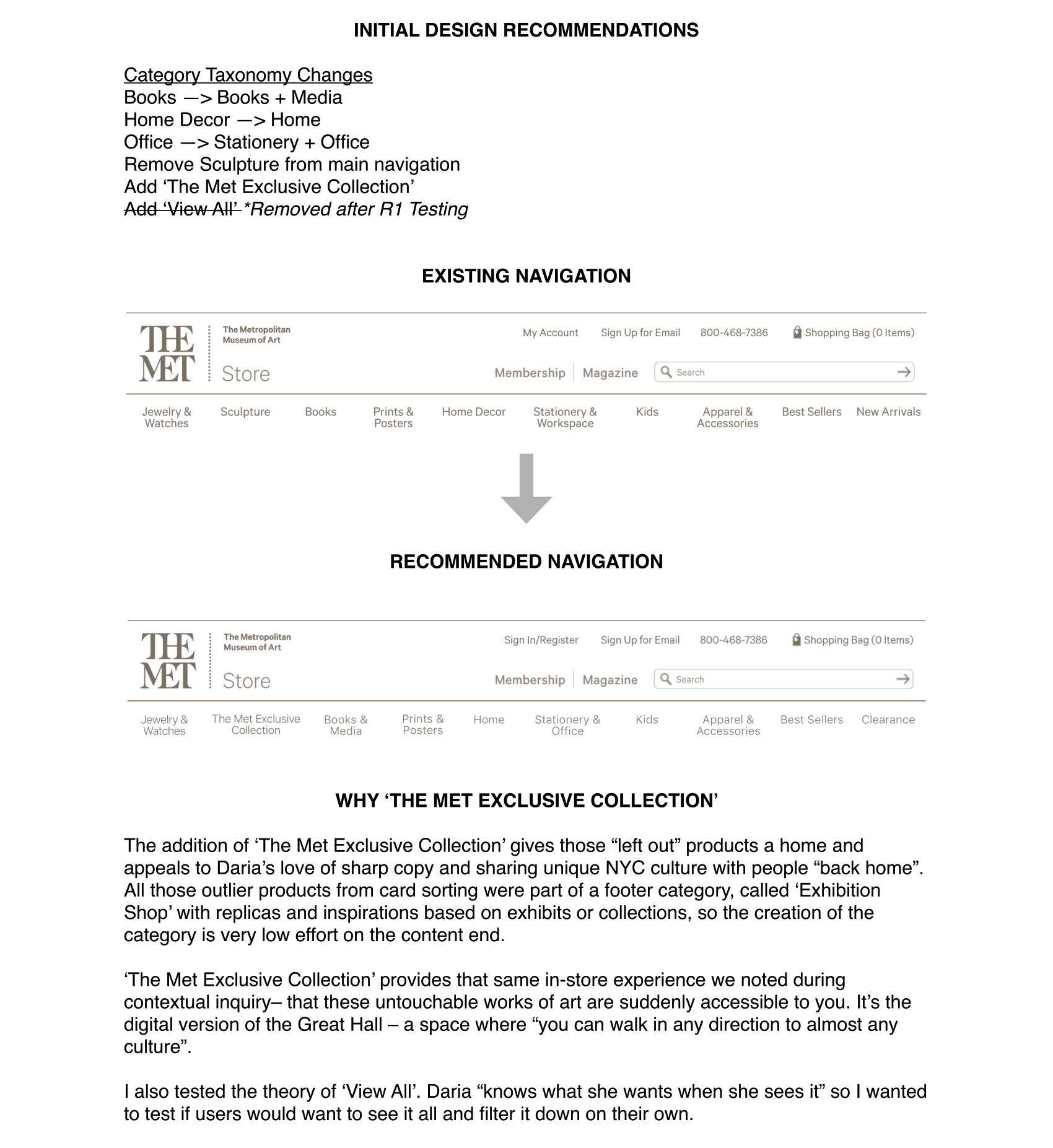
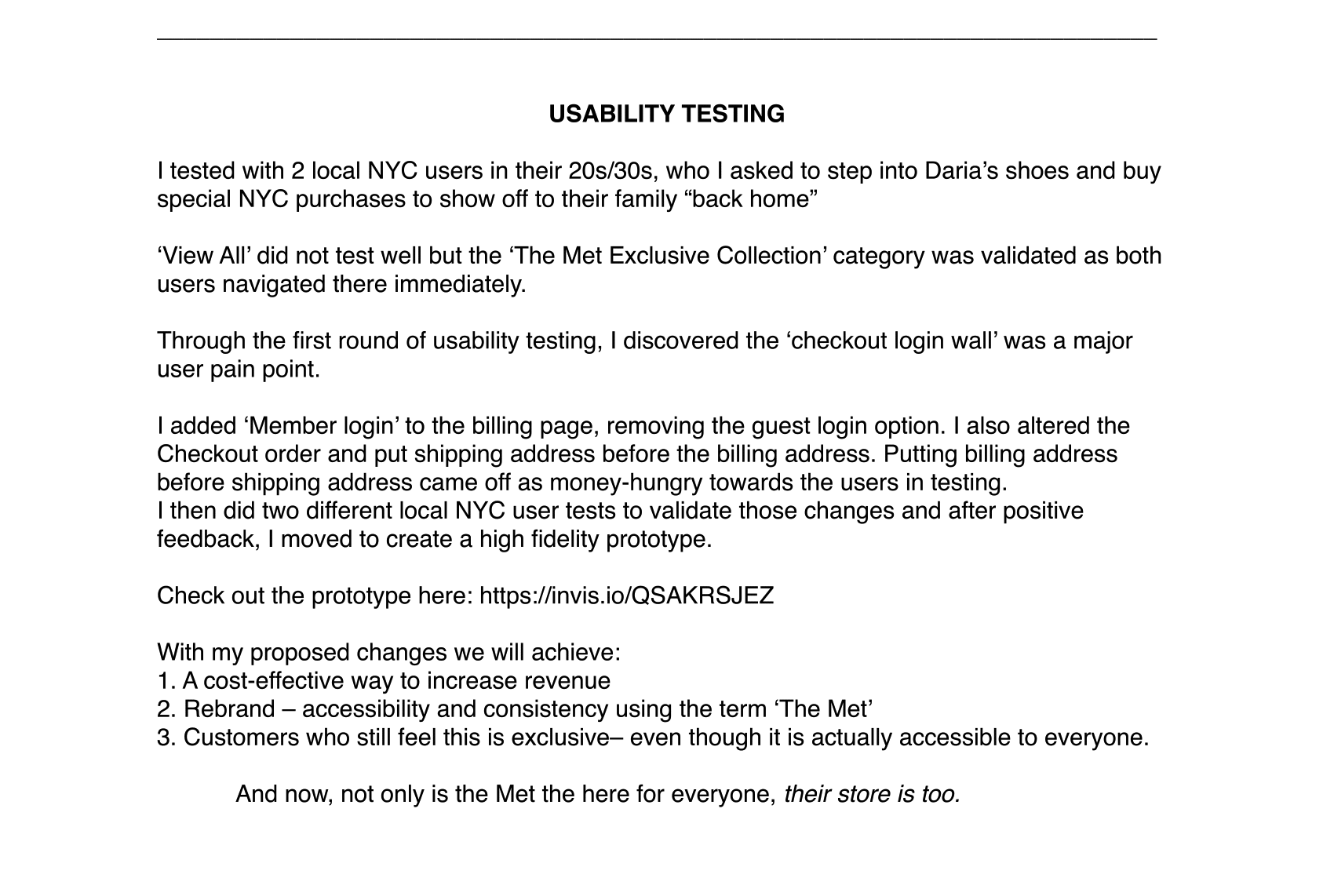
Making FOIL transparent, efficient and human.
I worked alongside a web developer and network engineer to produce design recommendations for the Freedom of Information Law. Over 8 hours, we rapidly worked through the entire UX process from user interviews to design studio, submitting our mid-fidelity wireframes and a final prototype.

New Feature Creation: Turning Form Request Emails into Actions
Currently being implemented by development team; live link coming soon!
Summary: I worked with their CTO from research and ideation through to design studio and low-fidelity wireframes, creating a form creation workflow.
Role: UX Design Consultant
Hive is a fast-growing teamwork platform used by WeWork, PWC, Uber and thousands of companies around the world.
Read more about Hive
How might we make creating request forms and managing those requests clear and seamless for two new clients with similar but distinct needs?
The clients both internally need to create request forms and then automate the workflow within the existing Hive platform.
Google Forms, Zapier, Wrike, Typeform
Features we looked at:
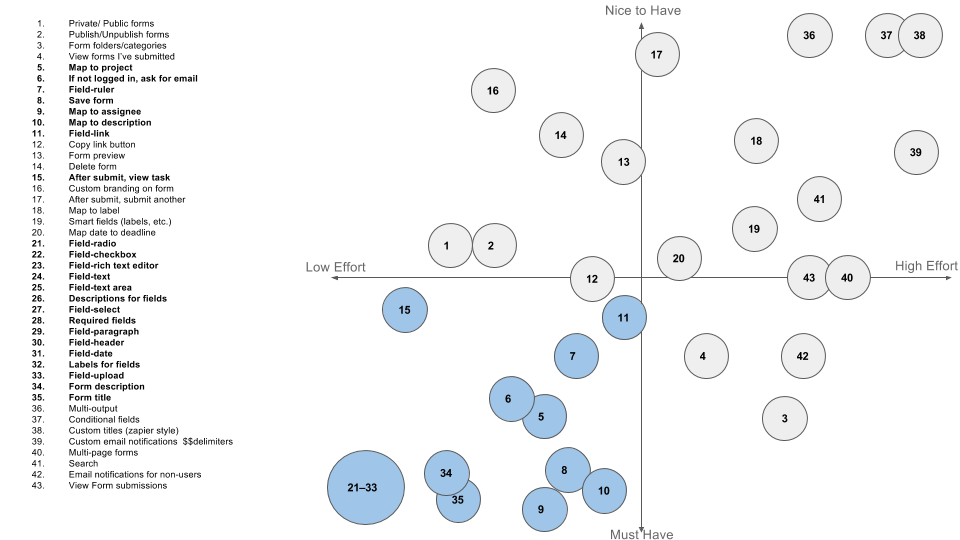
We quickly listed out all the possible aspects of the feature and prioritized the aspects. The chart positioned items by low and high effort along the x axis, and nice to have and must have along the y axis. In the end, we were able to narrow down the features to the blue items, as the MVP for Forms 1.0.
Using a method called Design Studio, we sketched in five minute intervals, diverging and converging to build off the other's ideas.
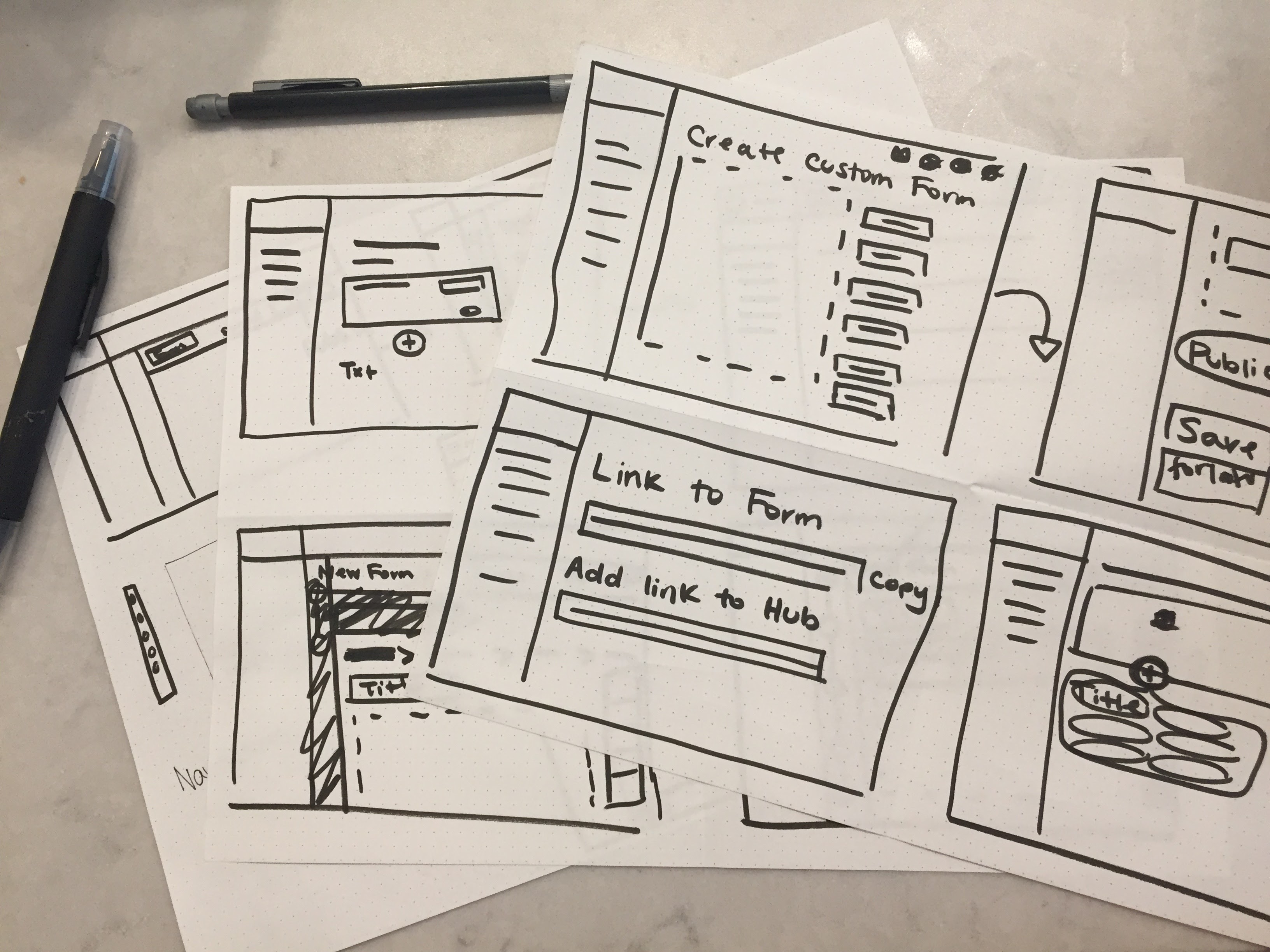

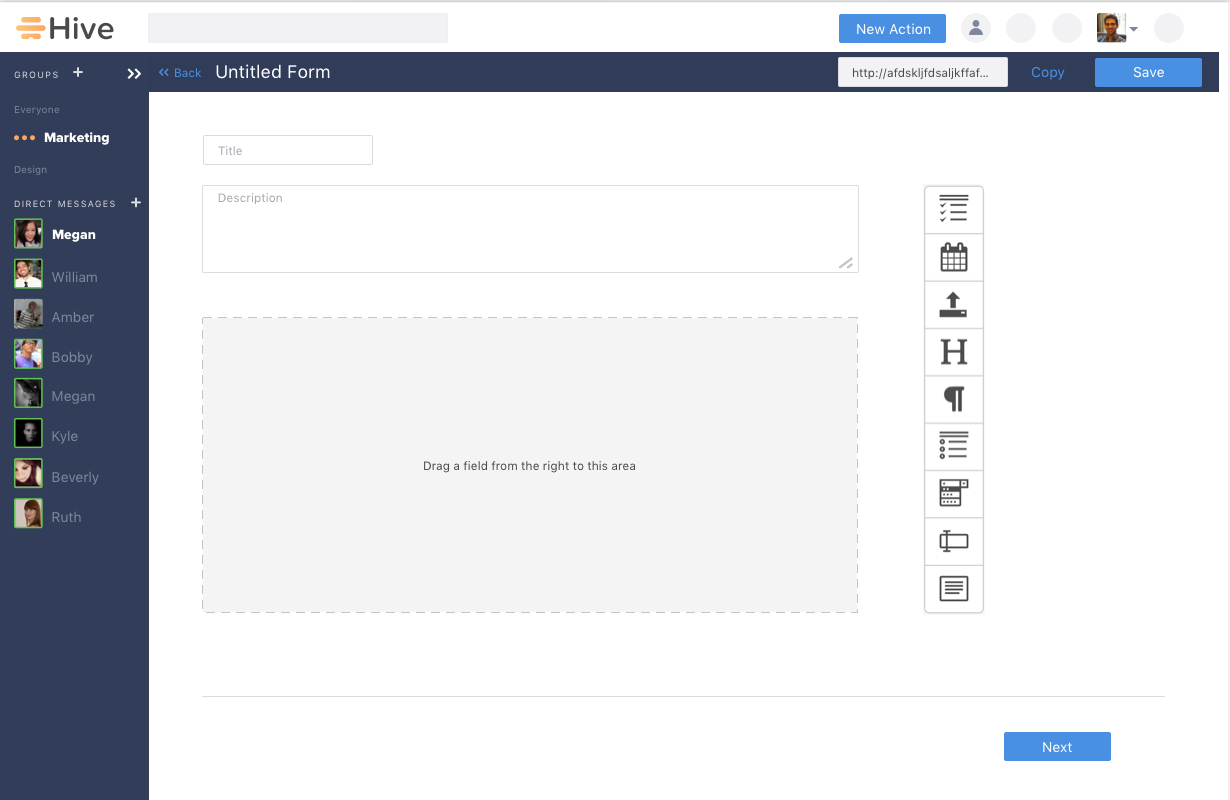
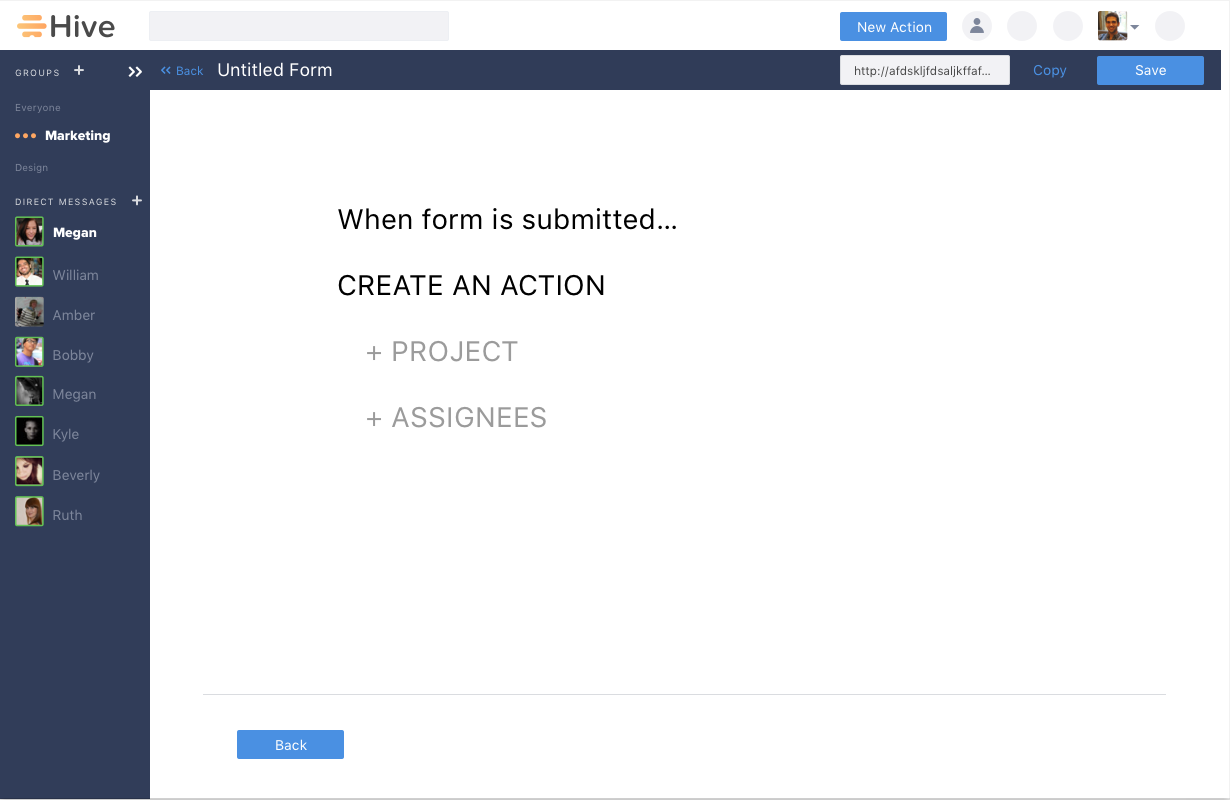
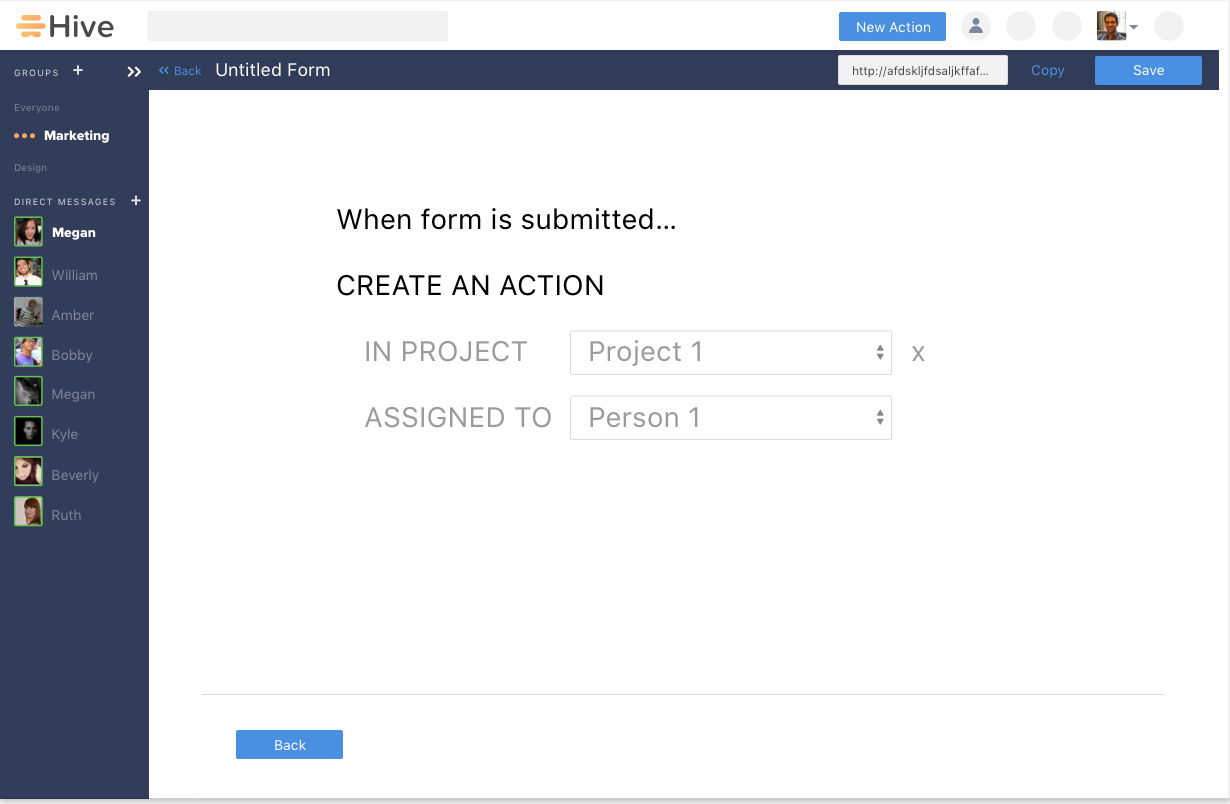
.

